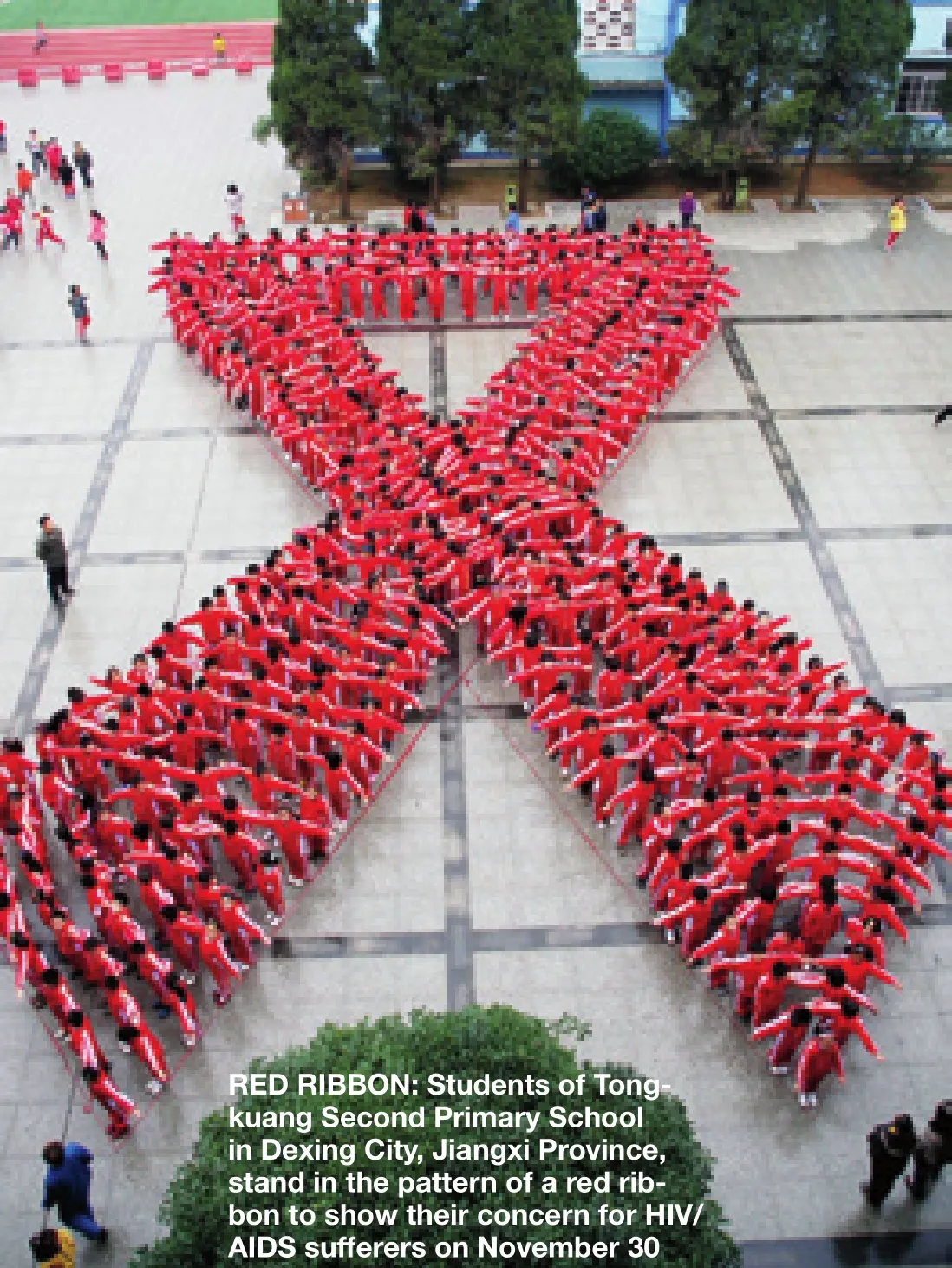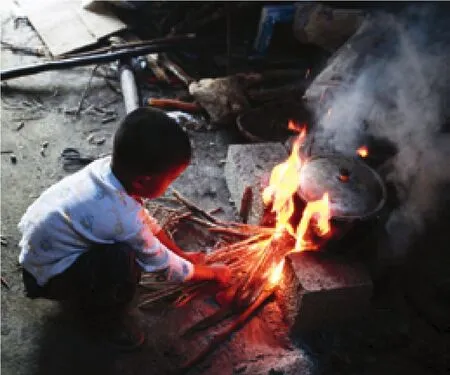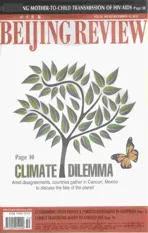A Red Ribbon for Children
2010-10-14ByWANGHAIRONG
By WANG HAIRONG
A Red Ribbon for Children
By WANG HAIRONG
The HIV/AIDS epidemic is affecting children and efforts are being taken to prevent mother-to-child transmission
A-Long lives by himself in a small,windowless cement-block cottage.He is 6 years old and his mother passed away a year ago due to AIDS. Earlier this year, he lost his father to the same disease. After his father’s death,A-Long was also diagnosed HIV positive.
His home is at the end of a muddy road halfway up a hill in Niucheping Village, Liuzhou City of Guangxi Zhuang Autonomous Region.
The only person close to A-Long is his 84-year-old grandmother, who lives 15 minutes away. She is unwilling to move in with the boy, as she is afraid of getting infected.
The grandmother often comes to see A-Long in the afternoon, but not every day. On her visits, she usually cooks for him and she has also planted two plots of vegetables in an open area beside the house. She says this should be enough for him to eat.
A-Long washes his clothes and cooks his meals when his grandmother is not visiting. His“kitchen” is an aluminum pot on several large cement blocks. He usually boils rice with vegetables picked from the yard. His cooking fuel is tree branches picked up nearby.
He plays by himself and studies by himself. He also feeds chickens and the dog his parents left him. At night, the dog,named Old Black, is his only companion.
From time to time, some kind-hearted people give A-Long toys and living supplies. A staff member of the village committee says they can guarantee he doesn’t have to worry about food and clothing at the moment and they have already helped him apply for social security bene fi ts:70 yuan ($10.5) per month for this year and 100 yuan ($15) per month next year.
A-Long has reached school age. His grandmother wanted to send him to a local primary school, but other students’ parents protested against it. Under the pressure, the school did not admit the 6-year-old orphan.
Once, A-Long accidentally burned his hand while cooking, but the local doctor did not dare to treat his wound.
A-Long’s story has been widely circulated in Chinese media recently. Now, he has been accepted by a charity organization,reported theBeijing Youth Daily.
The epidemic

ZHUO ZHONGWEI
A-Long’s story reminds people of the stigma associated with HIV/AIDS infection. By 2009, about 740,000 people in China were living with HIV/AIDS, the Ministry of Health, UNAIDS and the World Health Organization jointly estimated.
But the Ministry of Health announced at the end of November that only 370,393 HIV/AIDS infected persons had been reported in China by October, including 132,440 suffering from full-blown AIDS and 68,315 dead from the disease.
More than half of HIV carriers are either unaware of their infection or reluctant to report it, which contributes to a discrepancy between estimated and reported cases.The epidemic continues to expand, but at a slower rate, said the Ministry of Health.
HIV/AIDS is mainly spread through sex in China.Initially, the primary transmission modes were intravenous drug use and blood donation.Heterosexual transmission accounted for 47.1 percent of cases reported in 2009, up from 40.3 percent in 2008.Geographic distribution is highly varied, and some particular sub-populations are seriously affected. Of the reported cases, 77.1 percent occur in six provincial level administrative units such as Yunnan, Guangxi,Henan, Sichuan, Xinjiang and Guangdong, said the Ministry of Health.
Some people think AIDS is an adult disease.Nonetheless, the United Nations Children’s Fund(UNICEF) points out the epidemic is affecting China’s children heavily and in many different ways.UNICEF estimates in China the number of children under 15 who have lost one or both parents to AIDS is far higher than 76,000.
Studies show a majority of children lose hope for the future and self-value when they learned their parents developed AIDS symptoms.
Children themselves can be infected. Ninety percent of HIV positive children under the age of 15 were infected through mother-to-child transmission, said Wang Linhong,Deputy Director of the National Center for Women and Children’s Health at the Chinese Center for Disease Control.
Mother-to-child transmission accounted for 1 percent of total HIV/AIDS cases and 1.6 percent of those reported between January and October in 2007, said the Joint Assessment Report by China’s State Council AIDS Working Committee Office and the UN Theme Group on AIDS in China published in 2007.
About 70 percent of total of HIV positive persons in China were males, said Wang.The increase in heterosexual transmission in China means a larger number of women are at risk, and so are children.
An HIV-positive mother can infect her child during pregnancy, delivery and breastfeeding. Clinical studies show about 81 percent of infections occurred during pregnancy and delivery, whereas 9 percent happened during breastfeeding, said Wang.
Anti-retroviral therapy,caesarean delivery and feeding infants with formula milk can reduce the likelihood of transmission. Expectant mothers can also opt to terminate the pregnancy.
Transmission prevention
China piloted the prevention of mother-to-child transmission in 2002. In 2003, the Ministry of Health officially launched the prevention program in eight counties or cities in the most seriously affected places.
The prevention program has been scaled up over the years.Now free mother-to-child transmission prevention services are available in 1,156 counties, or about 40 percent of all counties in China, Wang said. Almost all counties in seriously affected provinces and autonomous regions have been covered.
Currently, national surveillance of pregnant women shows 0.05 percent of them are infected with HIV, Wang said. To her knowledge about 20 percent of the infected choose abortion.
Without intervention, the probability of mother-to-child transmission in China is about one third; now doctors are able to bring the average chance of transmission down to 5 percent, Wang said.
More pregnant HIV-positive mothers would like to give birth as medical technology and practices have reduced the chance of infection, Wang said.
Under the government’s “Four Frees and One Care” policy, HIV positive pregnant women can get free drugs to prevent motherto-child transmission and newborn babies can get free HIV testing.
The “Four Frees and One Care” policy also offers free AIDS drugs to rural residents or city-dwellers without insurance, as well as free voluntary counseling and testing in seriously affected regions, free schooling for AIDS orphans and care and economic assistance to needy households of those living with HIV/AIDS.
AIDS program in Beijing
Treating HIV/AIDS sufferers is a specialization of Beijing Ditan Hospital. The hospital treated its fi rst AIDS case in 1987.Since then, it has had a total of 1,064 AIDS out-patients and 545 in-patients. It has a dedicated AIDS ward, which can accommodate 41 in-patients at any given time, according to the hospital.

LIFE IN SOLITUDE: A-Long, a 6-year-old orphan from Guangxi Zhuang Autonomous Region, lights up a fire to cook meal at home
A number of doctors and nurses in the hospital have received training on treating AIDS patients in such countries as the United States, the UK, Japan and Thailand.The AIDS program is at an advanced level in China, and has reached international standards.
The hospital started its program to prevent mother-to-child HIV transmission in 2003. Currently, 20 to 30 HIV positive mothers deliver babies in the hospital each year, said Pang Lin, director of the hospital’s pediatrics department.
The newborns are tested 42 days, six months and 18 months after birth. Tests show so far, all these newborns are HIV free,Pang said.
Sometimes, it is difficult to follow up with the newborns, Pang said. After leaving the hospital, the newborn’s family might change telephone numbers or addresses, intentionally for anonymity or unintentionally after moving.
Pang has engaged in the prevention and treatment of AIDS among children since 2004, after conducting a year of research on infection and immunity at Vanderbilt University in the United States.
When asked whether her family members and friends worry that she could get the virus and transmit it to them, Pang said that some of the people she knew were concerned, but as her parents and husband are all doctors, they understand her choice.
“AIDS is just another infectious disease,just like hepatitis B and many other contagious diseases,” Pang said, adding that, as long as proper medical procedures are followed, it should be fi ne.
The number of HIV infected mothers that have given birth in the hospital has increased over the years, due to wider coverage of HIV surveillance and knowledge about preventive measures,Pang said.
Prevalence of HIV/AIDS in Beijing is low, except for particular high-risk groups, said Zhao Chunhui, the deputy head of Beijing Municipal Health Bureau.
Zhao said on November 30 that, a total of 8,395 cases had been documented since the fi rst case was reported in the city in 1985. About 48.1 percent of total cases were sexually transmitted, reported Xinhua News Agency.
In Beijing Ditan Hospital,there is also a Home of the Red Ribbon, which was originally founded in 1999 as an of fi ce to serve HIV/AIDS sufferers.
The red ribbon is an international symbol of HIV/AIDS awareness. It is worn by people to show care and concern.
Over the years, the Home of the Red Ribbon has grown into an independent nonprofit organization that offers medical and psychological consultation plus legal assistance to people living with HIV/AIDS. It also organizes advocacy activities, with help from numerous volunteers.
When talking about what her organization can do for AIDS orphans like A-Long,Wang Kerong, director of the organization’s of fi ce, said they help them to get free AIDS treatment and medicine, and apply for assistance from local civil affairs departments.
“We have helped a total of more than 10 children to get medical treatment for AIDS in Beijing Ditan Hospital,” Wang said.
